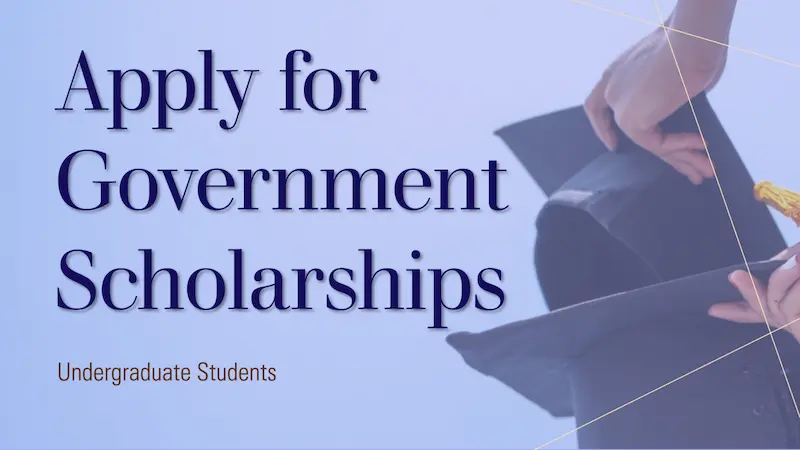Are you a college student worried about tuition fees, books, or living expenses? If yes, you’re not alone. Many students face financial challenges while pursuing higher education. Fortunately, government scholarships for college students are designed to ease this burden. These scholarships provide financial support so students can focus on their studies and achieve their academic dreams.
In this guide, we will explore everything you need to know about government scholarships: the types, eligibility criteria, how to apply, top programs, and tips to maximize your chances of success.
What Are Government Scholarships for College Students?

Government scholarships for college students are financial awards offered by government bodies—national, state, or local—to support higher education. Unlike loans, scholarships do not require repayment, which makes them highly valuable for students from all backgrounds.
The primary goals of these scholarships are:
- Promote Higher Education: Encourage talented students to pursue college degrees.
- Support Financially Disadvantaged Students: Make education accessible for everyone.
- Reward Academic or Other Achievements: Recognize students’ excellence in academics, arts, sports, or community service.
Benefits of Government Scholarships
- Full or Partial Tuition Coverage: Some scholarships cover all tuition fees, while others provide partial assistance.
- Living and Educational Expenses: Certain scholarships include allowances for books, accommodation, travel, and meals.
- Networking and Career Opportunities: Some programs offer mentorship, internships, or training opportunities alongside financial aid.
Types of Government Scholarships for College Students
Government scholarships are diverse, catering to different types of students and needs. The main types include:
1. Merit-Based Scholarships
These scholarships reward academic excellence or exceptional talent. Students with high grades, exceptional performance in exams, or achievements in arts, sports, or leadership roles are eligible.
Examples:
- Scholarships for top-performing students in national exams
- Awards for students winning competitions or Olympiads
2. Need-Based Scholarships
If your family cannot afford tuition fees or living expenses, need-based scholarships are ideal. Governments evaluate family income, economic conditions, and other financial factors before awarding these scholarships.
Examples:
- Scholarships for low-income families
- Grants for students from rural or underprivileged areas
3. Special Category Scholarships
Some government scholarships target specific groups of students:
- Women Scholarships: Encouraging female participation in higher education, particularly in STEM fields.
- Minority Scholarships: Supporting ethnic or religious minority students.
- Students with Disabilities: Ensuring equal access to higher education.
- Field-Specific Scholarships: For students pursuing careers in public service, medicine, technology, or agriculture.
How to Apply for Government Scholarships

Applying for a government scholarship can seem overwhelming, but breaking it into steps makes it manageable. Here’s a step-by-step guide:
Step 1: Research Available Scholarships
Start by checking official government websites, educational portals, or scholarship databases. List all scholarships for which you qualify.
Step 2: Understand Eligibility Criteria
Read the eligibility requirements carefully. Missing a small criterion could disqualify you. Check age limits, academic requirements, nationality, and field of study.
Step 3: Gather Required Documents
Commonly requested documents include:
- Academic transcripts and certificates
- Proof of income or financial need
- Identity documents (like passport or national ID)
- Letters of recommendation
- Personal essays or statements
Step 4: Complete the Application Form
Fill in the scholarship application accurately. Pay attention to details and follow instructions carefully. Avoid mistakes that could delay processing.
Step 5: Submit Before the Deadline
Government scholarships have strict deadlines. Submit your application on time, ideally a few days before the last date.
Step 6: Follow Up and Prepare for Interviews
Some scholarships may require interviews, additional documents, or verification. Stay updated and respond promptly.
You may also like to read this:
Best Career Planning Tips For Students To Follow
Future Career Options After School | Complete Guide
How To Prepare For Job Interviews And Land Your Dream Job
Guide To Latest Scholarships In The Philippines 2025–2026
International Scholarships For Filipino Students 2025–2026
Popular Government Scholarships (Examples by Country)
United States
- Pell Grant: A need-based grant for undergraduate students from low-income families.
- Fulbright Program: Supports U.S. students studying or conducting research abroad.
- SMART Scholarship: Full tuition coverage for students in STEM fields.
India
- National Merit Scholarship: Rewarding top-performing students in academics.
- Post Matric Scholarships for SC/ST/OBC: Supporting students from reserved categories.
- INSPIRE Scholarship: For students excelling in science and innovation.
United Kingdom
- Chevening Scholarships: For international students pursuing a master’s degree.
- Commonwealth Scholarships: For students from Commonwealth countries.
Australia
- Australia Awards Scholarships: Fund tuition, travel, and living costs for international students.
Most governments offer numerous scholarships; always check your local and national education departments.
Tips to Maximize Your Chances
- Start Early: Many scholarships have early deadlines; begin your research at least 6–12 months in advance.
- Write a Strong Essay: Highlight your achievements, goals, and why you deserve the scholarship.
- Request Recommendations Early: Ask teachers, mentors, or employers in advance for recommendation letters.
- Keep Documents Ready: Maintain organized copies of all academic and financial documents.
- Apply Widely: Apply for multiple scholarships to increase your chances.
Common Mistakes to Avoid
- Submitting incomplete applications
- Missing deadlines
- Ignoring eligibility criteria
- Writing generic essays instead of personalizing them
- Forgetting to proofread applications
Final Thoughts
Government scholarships for college students are a fantastic opportunity to reduce financial stress while pursuing higher education. They provide not only monetary support but also mentorship, career opportunities, and recognition for your achievements. Whether you are aiming for merit-based, need-based, or special category scholarships, careful research, early preparation, and a well-crafted application can greatly increase your chances.
Take advantage of these opportunities and make your college journey more affordable and rewarding.
FAQs
Q1: Can international students apply for government scholarships?
A: Some scholarships accept international students. Check each eligibility carefully.
Q2: Are these scholarships renewable every year?
A: Many government scholarships are renewable if you maintain a minimum GPA or meet other performance criteria.
Q3: Do government scholarships cover living expenses?
A: Some do, especially those designed for low-income or international students. Always check the award details.
Q4: Can I apply for more than one scholarship?
A: Yes, provided you meet the eligibility requirements for each.
Q5: Is applying online necessary?
A: Most scholarships have moved to online applications, but some still accept paper submissions.


